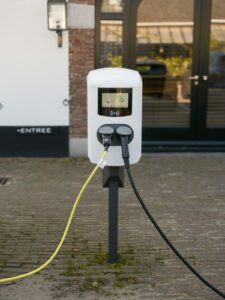
Home / EV Charging News / Second-life batteries: After being used in electric vehicles, batteries may still have enough capacity
As electric vehicles become more popular, the number of used batteries is also increasing. However, these batteries still have enough capacity to be used in second-life applications, such as energy storage systems. Here is a detailed overview of second-life batteries.
Electric vehicles (EVs) have become increasingly popular in recent years. However, as the number of EVs increases, so does the number of used batteries. Typically, EV batteries are considered “dead” when their capacity drops to around 70-80%. However, even after this point, they can still be used in second-life applications.
Second-life batteries are used batteries that have been retired from electric vehicles but still have enough capacity to be used for other applications. While they may not be suitable for use in an electric vehicle, they can still be used for energy storage systems, such as those used in homes and businesses.
There are several benefits to using second-life batteries. Firstly, they are cheaper than new batteries, which makes them an attractive option for energy storage systems. Secondly, using second-life batteries reduces waste and helps to promote sustainability. Finally, second-life batteries can help to increase the adoption of renewable energy sources by providing a more reliable source of energy storage.
There are also challenges associated with second-life batteries. Firstly, it can be difficult to assess the health of a used battery, which can lead to issues with reliability. Secondly, the market for second-life batteries is still relatively small, which makes it difficult to find buyers for the batteries. Finally, there is a lack of standardization when it comes to second-life batteries, which can lead to compatibility issues.
Second-life batteries can be used for a variety of applications, including:
The future of second-life batteries is looking bright, as more companies are starting to recognize their potential. For example, BMW has partnered with energy storage provider, Off Grid Energy, to repurpose used electric vehicle batteries for energy storage systems. Similarly, Nissan has launched its own second-life battery program, which uses retired Leaf batteries for energy storage applications.
As the demand for renewable energy sources continues to grow, the need for reliable energy storage solutions will also increase. Second-life batteries have the potential to fill this gap, by providing a cheaper and more sustainable source of energy storage.
While second-life batteries are a great way to extend the life of electric vehicle batteries, it is still important to recycle them properly at the end of their life. This is because electric vehicle batteries contain valuable metals, such as cobalt and lithium, which can be extracted and reused.
Recycling also helps to reduce the environmental impact of electric vehicle batteries, as it prevents the release of harmful chemicals into the environment. In addition, recycling can help to reduce the demand for new materials, which can help to reduce the carbon footprint of electric vehicle batteries.
In conclusion, second-life batteries have the potential to revolutionize the energy storage industry. By extending the life of electric vehicle batteries, we can reduce waste and promote sustainability. While there are challenges associated with the use of second-life batteries, the benefits of this technology make it a promising solution for energy storage. As more companies invest in second-life battery programs, we can expect to see widespread adoption of this technology in the near future.
$2,890.00 Original price was: $2,890.00.$2,790.00Current price is: $2,790.00.
$3,950.00 Original price was: $3,950.00.$3,450.00Current price is: $3,450.00.
$1,650.00 Original price was: $1,650.00.$1,590.00Current price is: $1,590.00.
$2,290.00 Original price was: $2,290.00.$2,150.00Current price is: $2,150.00.
$1,290.00 Original price was: $1,290.00.$799.00Current price is: $799.00.

Your Power Management Partner for Over 25 Years Future Generations Depend on Our Decisions Today ™
2024 © All rights reserved by CyberSwitching